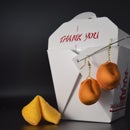Introduction: Glowing Comic/Anime Character Glasses
When tasked with creating a STEM activity for my local library's teen manga and anime club, I knew almost immediately that I wanted to make a pair of scary shiny glasses, having previously seen a viral video where someone else had created his own pair.
A trope made popular by comic book and manga/anime characters, like Kevin from the comic book series turned movie Sin City and Kyouya Ootori from the manga/anime Ouran High School Host Club, the glasses seemed like a fitting project for a group of teenagers who were likely to be budding cosplayers, and given the popularity of the trope, the teens could utilize the glasses for a variety of character costumes. However, the pair of light-up glasses featured in the video were--in my opinion--unnecessarily bulky and complex, especially for the time constraints of my two-hour class. So, in coming up with my own design, I knew I wanted deviate from the original in two ways:
First, I needed to create the glasses without the use of a soldering iron because, even if I had the time to teach approximately 15 teenagers how to solder, there wouldn't be enough irons to go around, and taking turns using the one or two available soldering irons would cut into precious class time.
Second, I wanted to integrate the power supply into the actual glasses and eliminate the cumbersome wires and battery pack used in the original design. I knew teenagers would appreciate the compactness and convenience of not having to tuck a battery pack out of sight when taking selfies or wearing the glasses as part of a cosplay.
Not using a soldering iron for the electrical connections really limited my options, but it also made the Lilypad-style coin cell holder the obvious choice for my project because of its integrated on/off switch and circular connection points for easy no-solder wiring.
Supplies
Materials
- (1 pair) Fake glasses with plastic lenses
- (2x) LilyPad coin cell battery holders with on/off switch
- (2x) CR2032 coin cell batteries
- (4x) 5mm White LED diodes - diffused
- Beige masking tape, 1.88-inch thick
Tools
- Fine grit sandpaper
- Hot glue gun
- Scissors
- Pen
- Needle or safety pin
Step 1: Prepping the Lenses
In order to create the scary shiny glasses, the lenses need to be prepped so that the light from the LEDs is diffused and appears to glow like a computer monitor in a dark room. This is achieved by making the lenses less transparent.
We begin by gently removing the lenses from the frame [Image 1.01] and taking fine grit sandpaper to the backside of the lenses (the side closest to your face when the glasses are worn), moving the sandpaper in a circular motion until the lenses become cloudy [Image 1.02]. To further increase opaqueness of the lenses, take a piece of ~2-inch-wide masking tape and attach it to the back of the lenses, sticky side touching the lenses [Image 1.03]. Trim away the excess tape from the edges [1.04].
The lenses will now diffuse the light, but before you can pop them back into the frame of the glasses, there is one more step to complete...
Step 2: Mapping the Electronics
Take your lenses and trace them onto some cardstock or other thin opaque material [Image 2.01]. The cardstock has two purposes:
- To provide a surface for mounting the electronics.
- To block out the light so that the LEDs do not blind you while wearing the glasses. (If you haven'y figured it out by now, you will not be able to see through the glasses while wearing them, but you can peer over them easily.)
Next, take your Lilypad-style battery holders, place them in the center of the lens outlines you drew on the cardstock, and then trace around them, making sure to mark and label where the negative and positive holes are located [Image 2.02].
Cut around the outlines of your lenses, leaving a little extra cardstock around the outside edges [Image 2.03]. Once you have cut them out, take a needle or pin and poke holes through the cardstock where you marked the negative and positive connections of the Lilypad on your outline [Image 2.04].
These cutouts will be your assembly diagrams for when you construct the glasses in the next step.
Step 3: Assembling the Glasses
To begin, gently pop your lenses back into the frame of the glasses [Image 3.01].
Take two LEDs and bend the anode (longer, positive leg) and cathode (shorter, negative leg) of each LED outwards and away from each other [Image 3.02]. Next, align one Lilypad battery holder with the diagram on the cardstock [Image 3.03] while on the backside [Image 3.04] you feed the legs of one LED through the positive and negative holes on diagram and on the Lilypad. Repeat the processes with a second LED and bend the wires of both LEDs around their respective holes (positive to positive, negative to negative) on the Lilypad to ensure a tight connection and a closed circuit [Image 3.05].
Note: I arranged my LEDs so that they both point inwards towards each other. If you want to have yours facing out, there's no reason you can't, and the end result will likely be the same. The important thing is that the anode and cathode are aligned with the correct holes.
Add a battery to the Lilypad and flip the power switch to the "on" position to test the connections [Image 3.06]. If you connected the LEDs to the appropriate holes on the Lilypad but one or both LEDs do not power on or they flicker, it is because the connection is not strong.
The best way to establish a strong connection is to solder the LEDs to the Lilypad, and if--unlike me and my class of teenagers--you have the opportunity to solder the connections, do so now. Otherwise, if you're following along for the no-solder method, bend those wires as tight as possible around the positive and negative holes in the Lilypad and use hot glue to secure them in place on both the Lilypad [Image 3.07] and back of the cardstock [Image 3.08] to prevent the wires from shifting.
After the hot glue has dried on the Lilypad and cardstock, add more hot glue around the inside rim of the glasses [Image 3.09] and glue the cardstock in place with the LEDs facing the lens of the the glasses [Image 3.10]. Trim away any excess cardstock peeking around the frame [Image 3.11].
Repeat all the previous steps for the other lens, and your glowing glasses are complete [Image 3.12]!
Step 4: Finished Glasses
Now that your glasses are ready to wear, it's time to go hang out in dark rooms and plot to take over the world!




